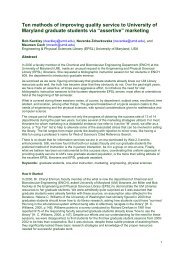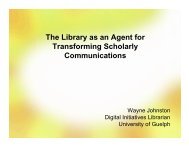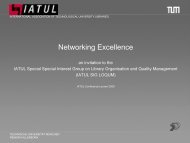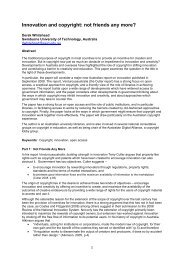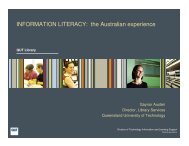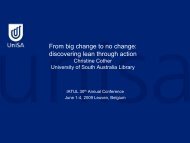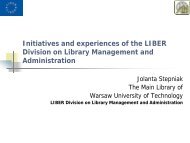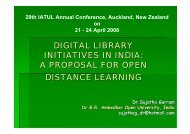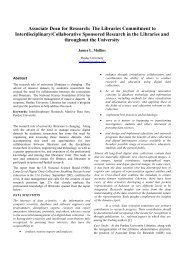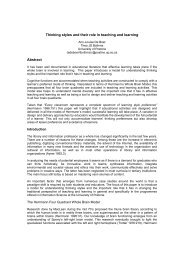Use of Web 2.0 Tools by Libraries: A Reconnaissance of the ... - IATUL
Use of Web 2.0 Tools by Libraries: A Reconnaissance of the ... - IATUL
Use of Web 2.0 Tools by Libraries: A Reconnaissance of the ... - IATUL
Create successful ePaper yourself
Turn your PDF publications into a flip-book with our unique Google optimized e-Paper software.
<strong>Use</strong> <strong>of</strong> <strong>Web</strong> <strong>2.0</strong> <strong>Tools</strong> <strong>by</strong> <strong>Libraries</strong>: A<br />
<strong>Reconnaissance</strong> <strong>of</strong> <strong>the</strong> International<br />
Landscape<br />
Dr. Manorama Tripathi<br />
Documentation Officer<br />
Indira Gandhi National Open University,<br />
New Delhi, India<br />
Email: manoramatripathi2@yahoo.com
<strong>Web</strong> <strong>2.0</strong> tools are Internet based services<br />
which include social net working sites,<br />
blogging sites, RSS, pod casting, wikis, 3D<br />
virtual environment such as second life and<br />
Active world.
These services aim to accelerate creativity,<br />
support information sharing, online<br />
collaboration and networking among <strong>the</strong><br />
users.. The use <strong>of</strong> web <strong>2.0</strong> tools has grown<br />
considerably in <strong>the</strong> education sector in <strong>the</strong><br />
last few years.
They are being emphatically and<br />
overwhelmingly adopted <strong>by</strong> <strong>the</strong><br />
conventional age students and <strong>the</strong> digital<br />
netizens. The libraries have also embarked<br />
upon harnessing <strong>the</strong> potential <strong>of</strong> <strong>the</strong>se<br />
applications for enhancing <strong>the</strong> services.
Highlights <strong>of</strong> <strong>the</strong> Paper:<br />
1. Discusses <strong>the</strong> application <strong>of</strong> <strong>the</strong>se tools in <strong>the</strong><br />
libraries .<br />
2. Provides a reconnaissance <strong>of</strong> major academic<br />
libraries across <strong>the</strong> globe which have embraced<br />
<strong>the</strong>se tools for connecting to <strong>the</strong> users.<br />
3. Discusses how <strong>Web</strong><strong>2.0</strong> tools can be used to woo<br />
patrons towards using <strong>the</strong> library resources and<br />
services.
Objectives <strong>of</strong> <strong>the</strong> Study:<br />
1. To identify web tools used <strong>by</strong> <strong>the</strong> academic<br />
libraries.<br />
2. To study <strong>the</strong> purpose <strong>of</strong> using <strong>the</strong>se<br />
technologies.<br />
3. To examine <strong>the</strong> characteristic features <strong>of</strong> <strong>the</strong><br />
web <strong>2.0</strong> tools used in <strong>the</strong> academic libraries.
Research Instrument:<br />
The parameters used in <strong>the</strong> present study<br />
are based on <strong>the</strong> checkpoints used <strong>by</strong><br />
McIntyre and Nicole(2007)for evaluating<br />
Library pod casts and <strong>the</strong> checkpoints given<br />
<strong>by</strong> Linh, Nguyen Cuong (2008) for<br />
evaluating various web <strong>2.0</strong> tools.
Research Instrument…<br />
It is also being mentioned here that certain<br />
checkpoints were arrived at after visiting<br />
and browsing <strong>the</strong> various sites. The list <strong>of</strong><br />
checkpoints.
Sample <strong>of</strong> <strong>the</strong> Study:<br />
1. United Kingdom (UK) : 82<br />
2. USA : 151<br />
3. Canada : 37<br />
4. Australia : 07<br />
Total = 277
University <strong>Libraries</strong>:<br />
The (libraries <strong>of</strong> <strong>the</strong> ) universities which are<br />
listed at <strong>the</strong> following sites were surveyed<br />
for <strong>the</strong> present study:<br />
http://www.scit.wlv.ac.uk/ukinfo/#<br />
http://www.utexas.edu/world/univ/state/<br />
http://university-canada.net/
Review <strong>of</strong> Literature:<br />
The literature review reveals that <strong>the</strong> use <strong>of</strong><br />
<strong>Web</strong> <strong>2.0</strong> in <strong>the</strong> libraries is increasing at an<br />
astonishing pace. The tools like blogs, RSS<br />
feeds, IM are used <strong>by</strong> <strong>the</strong> libraries very<br />
commonly; whereas <strong>the</strong> use <strong>of</strong> wikis is still<br />
to pick up.
Review <strong>of</strong> Literature…<br />
These tools may be used <strong>by</strong> <strong>the</strong> libraries for<br />
personalizing outreach services. The<br />
application <strong>of</strong> <strong>the</strong>se tools may help libraries<br />
<strong>of</strong>fer <strong>the</strong>ir resources and services to <strong>the</strong><br />
users in a proactive manner.
Data Analysis<br />
The data was collected according to <strong>the</strong><br />
checkpoints suggested <strong>by</strong> various authors<br />
for evaluation .Each check point was<br />
allotted a value 1or 0 according to yes/or<br />
no answer. The values were entered in<br />
Excel spreadsheets.
Data Analysis<br />
The “application index” <strong>of</strong> each library was<br />
calculated <strong>by</strong> <strong>the</strong> following formula:<br />
Application Index = Total <strong>of</strong> Yes answers X 100<br />
Total number <strong>of</strong> Checkpoints<br />
An application index indicates <strong>the</strong> degree <strong>of</strong><br />
adoption <strong>of</strong> <strong>Web</strong> <strong>2.0</strong> application in a specific<br />
library. (Linh, Nguyen Cuong, 2008).
Results and Discussions<br />
The mean <strong>of</strong> <strong>Web</strong> <strong>2.0</strong> application indexes<br />
has been calculated in <strong>the</strong> following<br />
manner:<br />
Mean application Index= Total <strong>of</strong> indexes<br />
Total number <strong>of</strong><br />
universities
Results and Discussions …<br />
The study covered 277 universities’<br />
libraries. It was found out that out <strong>of</strong> 277<br />
universities’ libraries, 211 or 76.17% had<br />
adopted some or <strong>the</strong> o<strong>the</strong>r web<strong>2.0</strong> tools<br />
whereas 66 <strong>of</strong> <strong>the</strong>m or 23.83% did not use<br />
any web <strong>2.0</strong> tools.
Results and Discussions…<br />
Out <strong>of</strong> 211 universities which had<br />
embraced some kind <strong>of</strong> web <strong>2.0</strong> tools,<br />
135 or 63.98% had Application Index<br />
above <strong>the</strong> mean <strong>of</strong> 14.22 whereas 76<br />
libraries or 36.02 % had Application<br />
Index below <strong>the</strong> mean <strong>of</strong> 14.22.
Results and Discussions …<br />
Out <strong>of</strong> 135 libraries which had Application<br />
Index greater than <strong>the</strong> Mean Application<br />
Index, 26 or19.25% were from Canada;5<br />
libraries or 3.72 % were from Australia;29<br />
libraries or 21.48 were from UK; and 75<br />
libraries or 55.55% were from USA.
Rank <strong>of</strong> first 20 libraries <strong>Libraries</strong>:<br />
Memorial University, New Founland : 51.94<br />
Dalhousie University, Canada : 38.96<br />
Regis University, Canada, USA : 38.96<br />
Gonzaga University, USA : 37.66<br />
Sacred Heart, USA : 36.36<br />
Thomas Jefferson University, USA : 36.36<br />
Lakehead University, Canada : 36.36<br />
University <strong>of</strong> East London, UK : 35.06<br />
Ryerson University, Canada : 35.06
Colorado State University, USA : 35.06<br />
Ball State University, USA : 35.06<br />
University <strong>of</strong> Sunderland, UK : 32.46<br />
University <strong>of</strong> Victoria, Canada : 32.46<br />
Brock University, Canada : 32.46<br />
Golden Gate, USA : 32.46<br />
Yale University, USA : 32.46<br />
Duke University, USA : 32.46
Princeton University, USA : 32.46<br />
University <strong>of</strong> Teesside, UK : 31.16<br />
Fairfield University, USA : 31.16<br />
University <strong>of</strong> Iowa, USA : 31.16
The libraries which had Application Index<br />
greater than <strong>the</strong> mean had adopted 2 or<br />
more web <strong>2.0</strong> tools whereas <strong>the</strong> ones which<br />
had Application Index less than Mean had<br />
adopted just one <strong>Web</strong><strong>2.0</strong> tool.
<strong>Use</strong> <strong>of</strong> <strong>Web</strong><strong>2.0</strong> tools in academic<br />
libraries in India<br />
Higher Education landscape in<br />
India
The following libraries use RSS:<br />
Central Library IIT, New Delhi http://www.<br />
iitd.ac.in/rss/iitdfeeds_library.xml<br />
Central Library IIT, Bombay http://www.<br />
library.iitb.ac.in//index
The following libraries use RSS…<br />
php?option=com_rss&feed=RSS1.<br />
0&no_html=1 Central Library, IIT,<br />
Kharagpur http://www.library.iitkgp.ernet.<br />
in/LibBlog/blogIndex.htm<br />
Library & Documentation Division, IGNOU<br />
http://libraryservicesignou.blogspot.com/
The following libraries use RSS…<br />
The libraries provide RSS feeds for new<br />
books, new journals, databases added to<br />
<strong>the</strong> libraries’ collection.
The Following <strong>Libraries</strong> <strong>Use</strong> RSS…<br />
The blog at Indira Gandhi National Open<br />
University provides <strong>the</strong> following<br />
information:<br />
1. Free trials arranged for <strong>the</strong> users.<br />
2. Timings <strong>of</strong> <strong>the</strong> Library.<br />
3. Workshops/user awareness programmer<br />
being organized for <strong>the</strong> readers.<br />
4. New databases being added to <strong>the</strong><br />
collection.
Good practices for integrating <strong>Web</strong><br />
<strong>2.0</strong> tools in library services<br />
1. The web <strong>2.0</strong> tools like blogs, RSS, social<br />
networking sites wikis should be actively<br />
used <strong>by</strong> <strong>the</strong> libraries.<br />
2. <strong>Libraries</strong> may use pod casts as training<br />
tools for databases and online library<br />
resources.
Good practices for integrating <strong>Web</strong><br />
<strong>2.0</strong> tools in library services…<br />
3. The libraries should create blogs in<br />
various subject areas. They should<br />
create blogs for announcing new<br />
developments and events taking place in<br />
<strong>the</strong> university. The blogs should be<br />
accessible to all but comment may be<br />
added <strong>by</strong> au<strong>the</strong>ntic students only.<br />
4. The libraries may publish guidelines for<br />
using blogs.
Good practices for integrating <strong>Web</strong> <strong>2.0</strong><br />
tools in library services…<br />
4. The libraries may publish guidelines for using<br />
blogs.<br />
5. May be asked to follow IPR with regard to<br />
content added <strong>by</strong> o<strong>the</strong>rs. The students should<br />
be told not to post any confidential information.<br />
6. Pod casts may be used for informing user<br />
community about what is going on in <strong>the</strong><br />
Library. Library tours may be provided on pod<br />
casts.
Good practices for integrating <strong>Web</strong> <strong>2.0</strong><br />
tools in library services…<br />
7. <strong>Libraries</strong> may use vodcasts to illustrate what<br />
<strong>the</strong> library has done and to attract community<br />
for future programmes. The libraries should<br />
prepare vodcasts on how to access library<br />
resources from <strong>of</strong>f campus; how to plan a<br />
search strategy and how to search articles in<br />
<strong>the</strong> online resources subscribed <strong>by</strong> <strong>the</strong><br />
Library. In this context, <strong>the</strong> example <strong>of</strong><br />
University <strong>of</strong> Aberdeen Library is worth<br />
mentioning.
Good practices for integrating <strong>Web</strong> <strong>2.0</strong><br />
tools in library services…<br />
8. The Library should run short term course on<br />
web <strong>2.0</strong> tools for <strong>the</strong> students and <strong>the</strong> faculty<br />
members.. The Chartered institute <strong>of</strong> Library<br />
and informational Pr<strong>of</strong>essionals (CILIP) runs 2<br />
courses like <strong>Web</strong> <strong>2.0</strong> nuts and bolts and <strong>Web</strong> <strong>2.0</strong><br />
: building on <strong>the</strong> basics. The students and<br />
faculty members should be taught to<br />
incorporate <strong>the</strong>se tools in <strong>the</strong>ir studies and<br />
progarmmes.
Good practices for integrating <strong>Web</strong> <strong>2.0</strong><br />
tools in library services…<br />
9. The libraries and information centers should<br />
create flyers and bookmarks with brief<br />
information about <strong>the</strong> blogs, RSS, wikis used in<br />
<strong>the</strong> library and distribute <strong>the</strong>m during<br />
orientation classes and informal visits to <strong>the</strong><br />
various departments.
Good practices for integrating <strong>Web</strong> <strong>2.0</strong><br />
tools in library services…<br />
10. The libraries may create a wiki where users<br />
may be allowed to create content on various<br />
educational aspects The wikis should be used<br />
<strong>by</strong> <strong>the</strong> <strong>Libraries</strong> for creating an online<br />
collaborative community in which <strong>the</strong><br />
students, staff, teachers may interact with one<br />
ano<strong>the</strong>r. These (wikis) may help <strong>the</strong> library<br />
staff in keeping constant track <strong>of</strong> <strong>the</strong> users’<br />
feedback. Henderson state University Library.
Scope for Fur<strong>the</strong>r Research<br />
1. The use <strong>of</strong> <strong>Web</strong> <strong>2.0</strong> tools in open<br />
universities and how <strong>the</strong>se have<br />
enhanced library services needs to be<br />
studied.
Scope for Fur<strong>the</strong>r Research<br />
2. Fur<strong>the</strong>r studies need to be undertaken<br />
regarding users’ feedback on <strong>the</strong>se<br />
web<strong>2.0</strong> .tools-whe<strong>the</strong>r <strong>the</strong>y feel more<br />
drawn towards <strong>the</strong> libraries because <strong>of</strong><br />
<strong>the</strong> application <strong>of</strong> <strong>the</strong>se tools or<br />
o<strong>the</strong>rwise.
Conclusion



